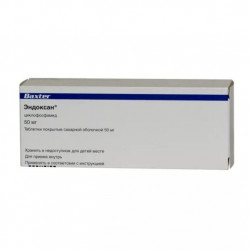



 All payments are encrypted via SSL
All payments are encrypted via SSL
 Full Refund if you haven't received your order
Full Refund if you haven't received your order
Cyclophosphamide
1 pill contains:
Active ingredients: cyclophosphamide 50 mg.
In the blister of 10 tablets. In carton pack 5, 40, 100 or 200 blisters.
Pharmacodynamics
Antitumor agent alkylating action. It has a cytostatic and immunosuppressive effect. The antitumor effect is realized directly in the tumor cells, where cyclophosphamide biotransformed by the action of phosphatases with the formation of an active metabolite with an alkylating action.
Pharmacokinetics
After a single intravenous administration, the concentration of cyclophosphamide and its metabolites in the plasma quickly decreases in the first 24 hours, but can be determined within 72 hours. When ingested, the concentrations of cyclophosphamide and its metabolites are almost the same as with intravenous administration.
T1/2 from plasma after i / v administration, an average of 7 hours in adults and about 4 hours in children. Excreted in urine and bile.
Cyclophosphamide is contraindicated during pregnancy. If necessary, use during lactation should decide on the termination of breastfeeding.
Women of childbearing age should use reliable contraceptive methods during therapy.
In experimental studies, the teratogenic and embryotoxic effects of cyclophosphamide have been established.
On the part of the digestive system: nausea, vomiting, diarrhea, stomach pain; rarely toxic hepatitis.
From the hemopoietic system: leukopenia, thrombocytopenia, anemia.
On the part of the respiratory system: with prolonged use of high doses - pneumonitis or interstitial pulmonary fibrosis.
Cardiovascular: tachycardia, shortness of breath, acute myopericarditis; in some cases - severe heart failure (associated with hemorrhagic myocarditis and myocardial necrosis).
On the part of the urinary system: aseptic hemorrhagic cystitis, nephropathy (associated with hyperuricemia).
Reproductive system: menstrual disorders, amenorrhea, azoospermia.
Allergic reactions: skin rash, urticaria, Anaphylactic reactions.
Other: alopecia, pain in muscles and bones, headache.
With simultaneous use of cyclophosphamide may enhance the effect of hypoglycemic drugs.
Combined use with Allopurinol can lead to increased myelotoxicity.
With simultaneous use with indirect anticoagulants, it is possible to change the anticoagulant activity (as a rule, cyclophosphamide reduces the synthesis of coagulation factors in the liver and disrupts the formation of platelets).
When combined with cytarabine, daunorubicin or doxorubicin, cardiotoxic effects may be enhanced.
When combined with the use of immunosuppressants increases the risk of infections and secondary tumors.
With simultaneous use of cyclophosphamide with lovastatin increases the risk of developing acute skeletal muscle necrosis and acute renal failure.
Drugs, which are inducers of microsomal enzymes, cause an increased formation of active metabolites of cyclophosphamide, which leads to an increase in its action.
They establish individually, depending on the evidence and the stage of the disease, the state of the hematopoietic system, the scheme of antitumor therapy.
Treatment: use of supportive measures, including appropriate treatment of infections, manifestations of myelosuppression and / or cardiotoxicity. There is no specific antidote. Symptomatic treatment.
It is not recommended to be used in patients with chickenpox (including recently suffered or after contact with the sick), with herpes zoster and other acute infectious diseases.
With caution used in patients with gout or nephrolithiasis in history, as well as after adrenalectomy (correction of hormone replacement therapy and doses of cyclophosphamide is necessary).
Cyclophosphamide is used with caution in patients with bone marrow infiltration with tumor cells, as well as in patients who received anticancer Chemotherapy or radiation therapy.
In the course of treatment, systematic monitoring of the peripheral blood pattern is necessary: during the main course 2 times / week; with maintenance treatment - 1 time / week. With a decrease in the number of leukocytes to 2500 / μl and platelets to 100 000 / μl, treatment must be stopped.
Against the background of the therapy, the activity of hepatic transaminases and LDH, the level of bilirubin, the concentration of uric acid in the blood plasma, diuresis and specific gravity of urine are monitored, and tests for the detection of microhematuria are carried out.
When using cyclophosphamide in higher doses in order to prevent hemorrhagic cystitis, it is advisable to assign mesna.
In experimental studies, the carcinogenic and mutagenic effects of cyclophosphamide have been established.
Sugar-coated tablets.
At a temperature not higher than 25 ° C
